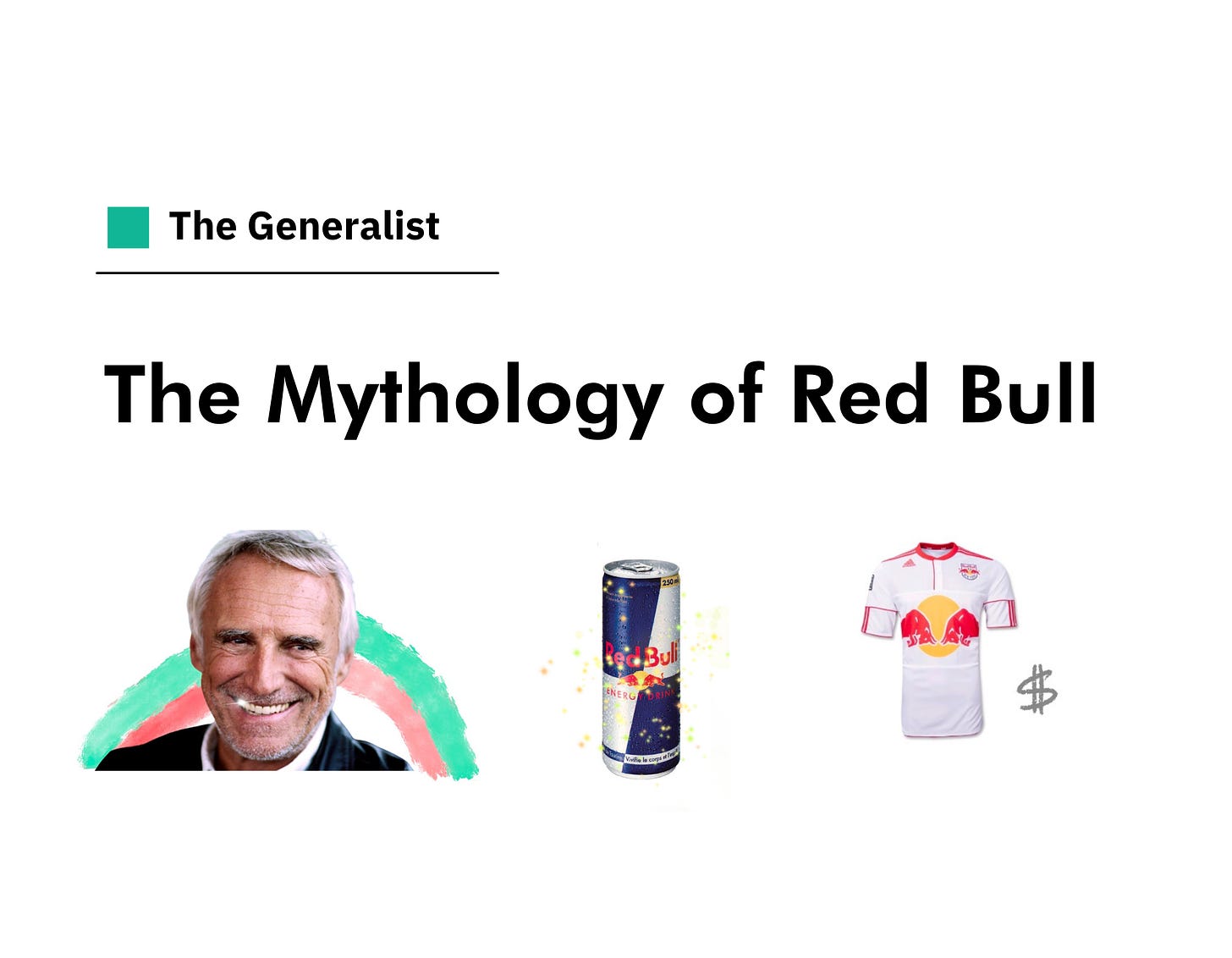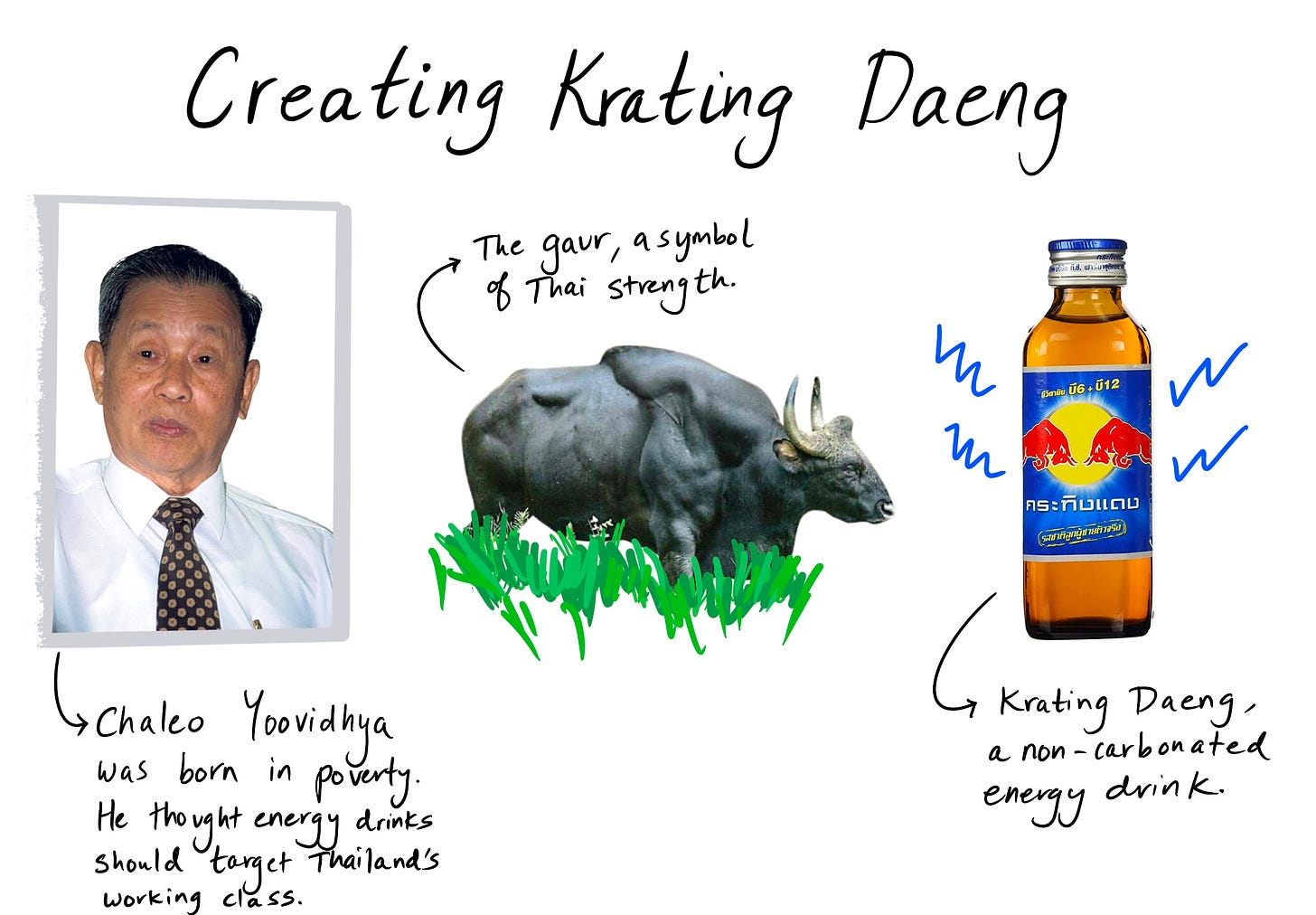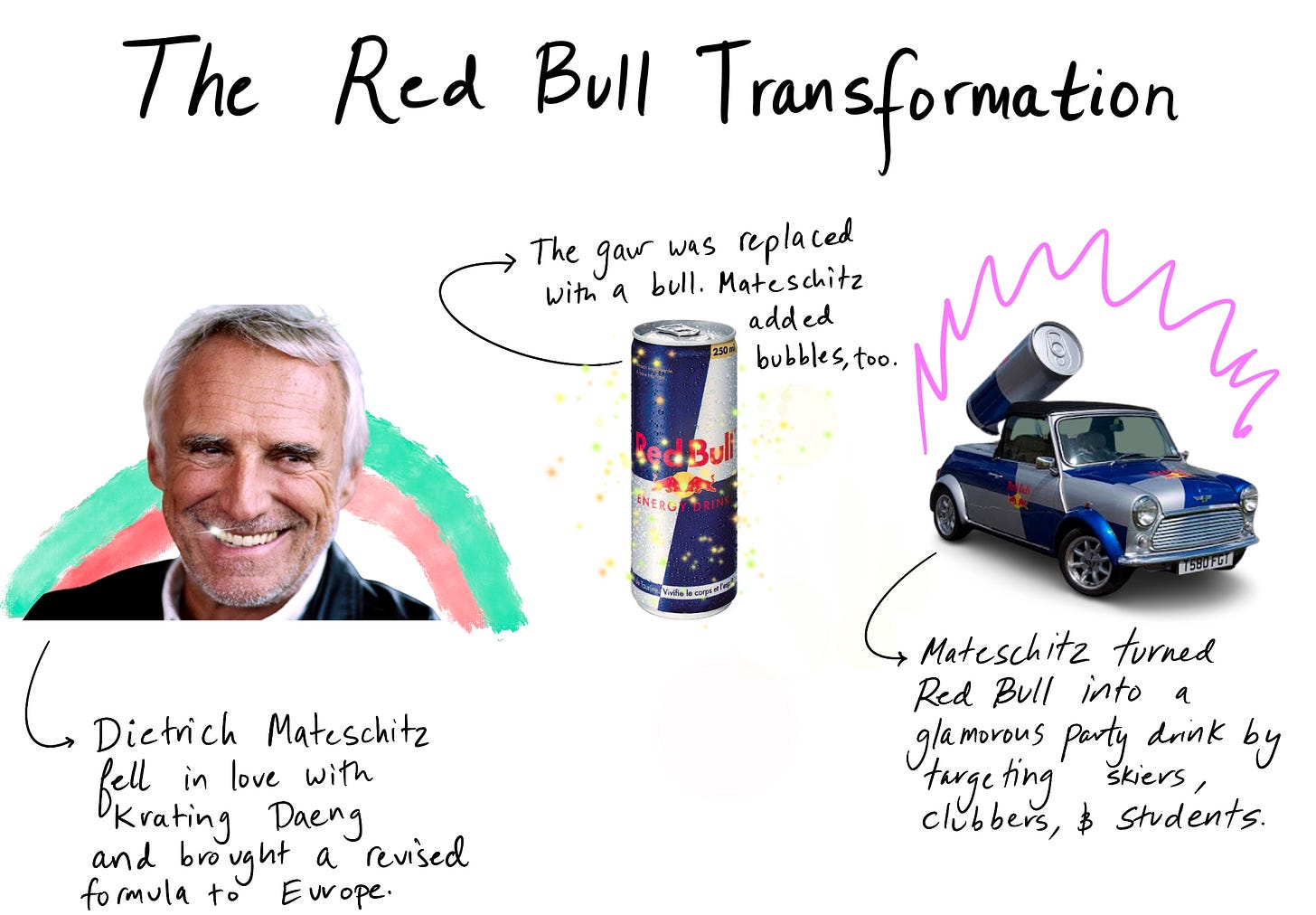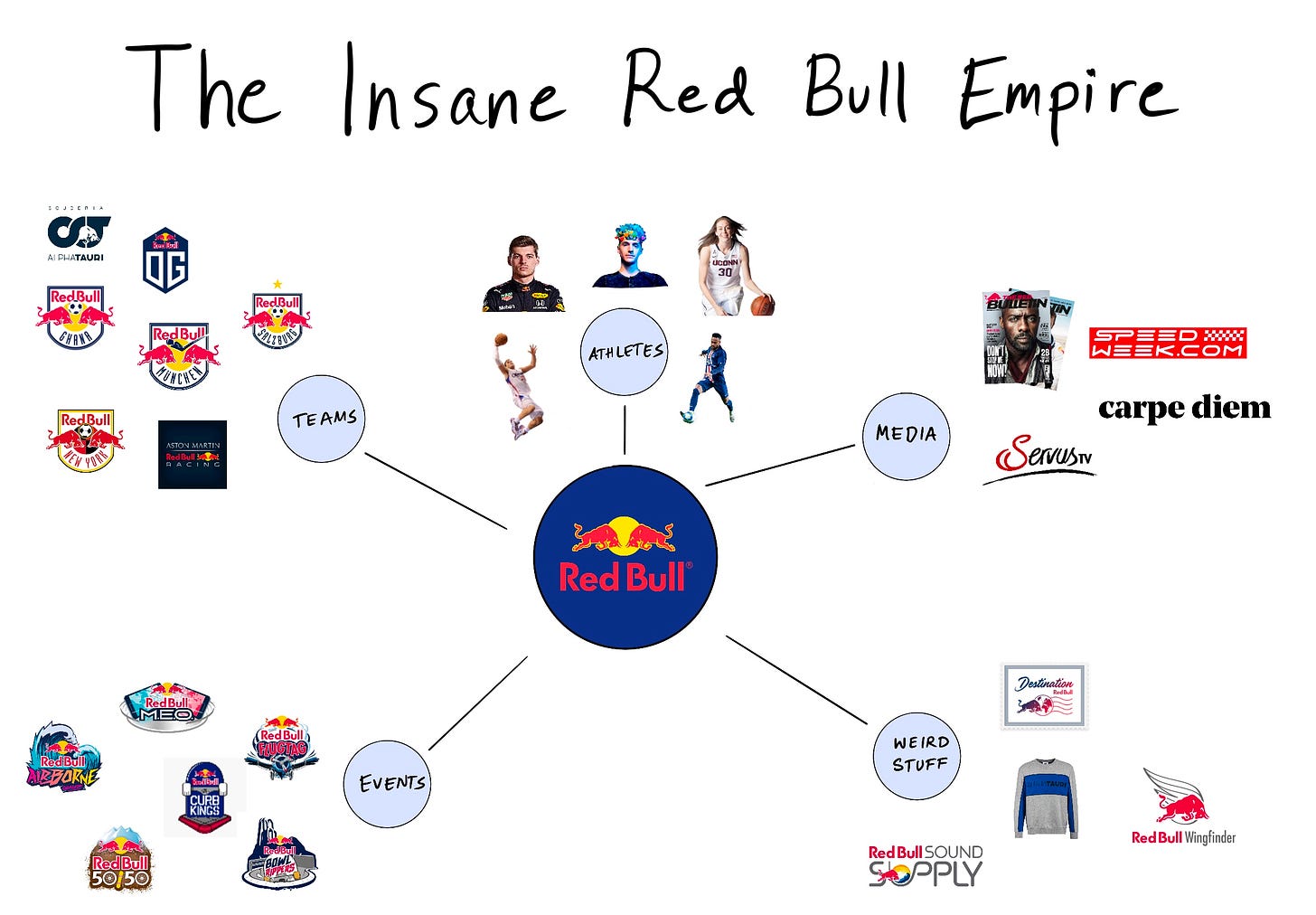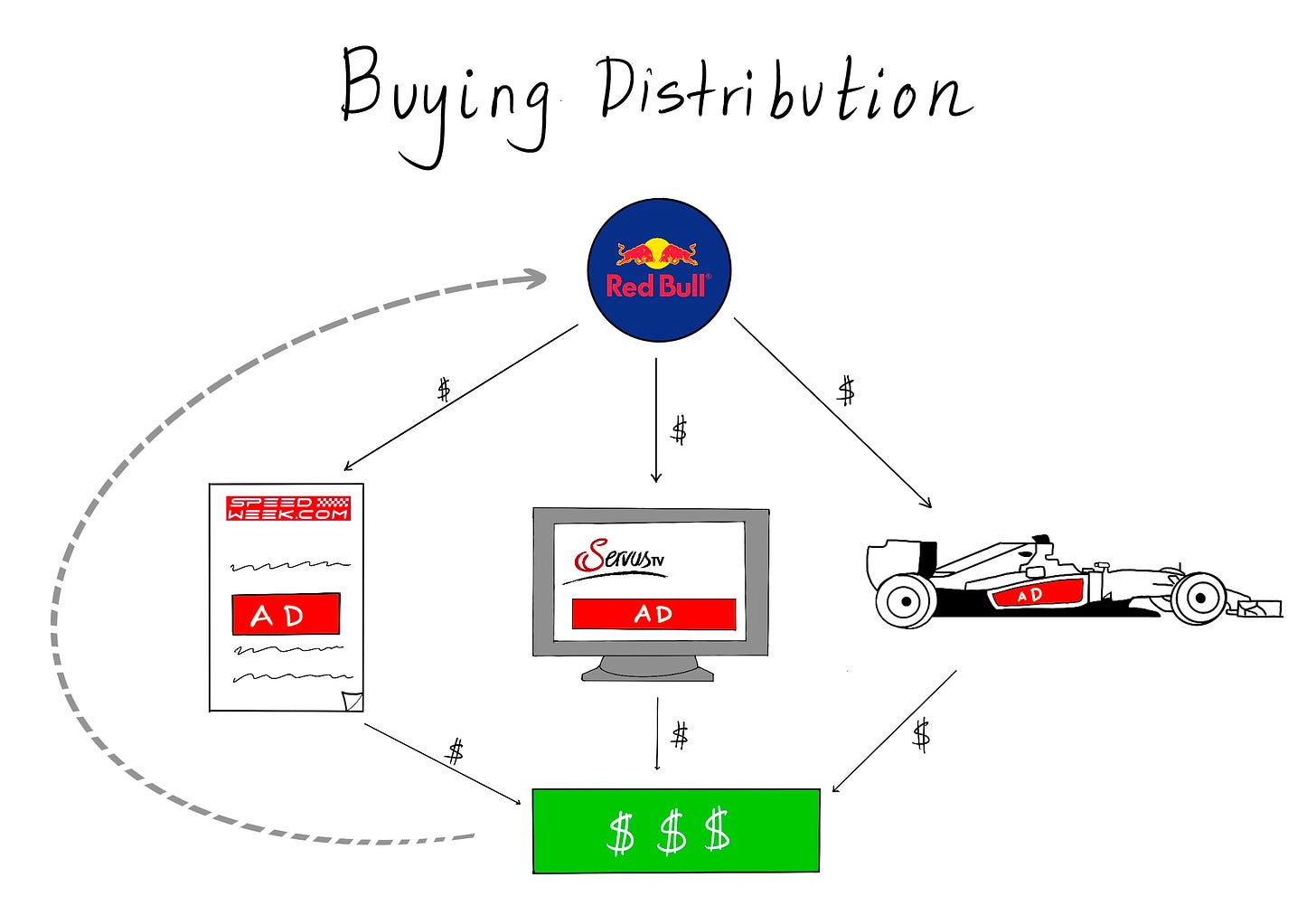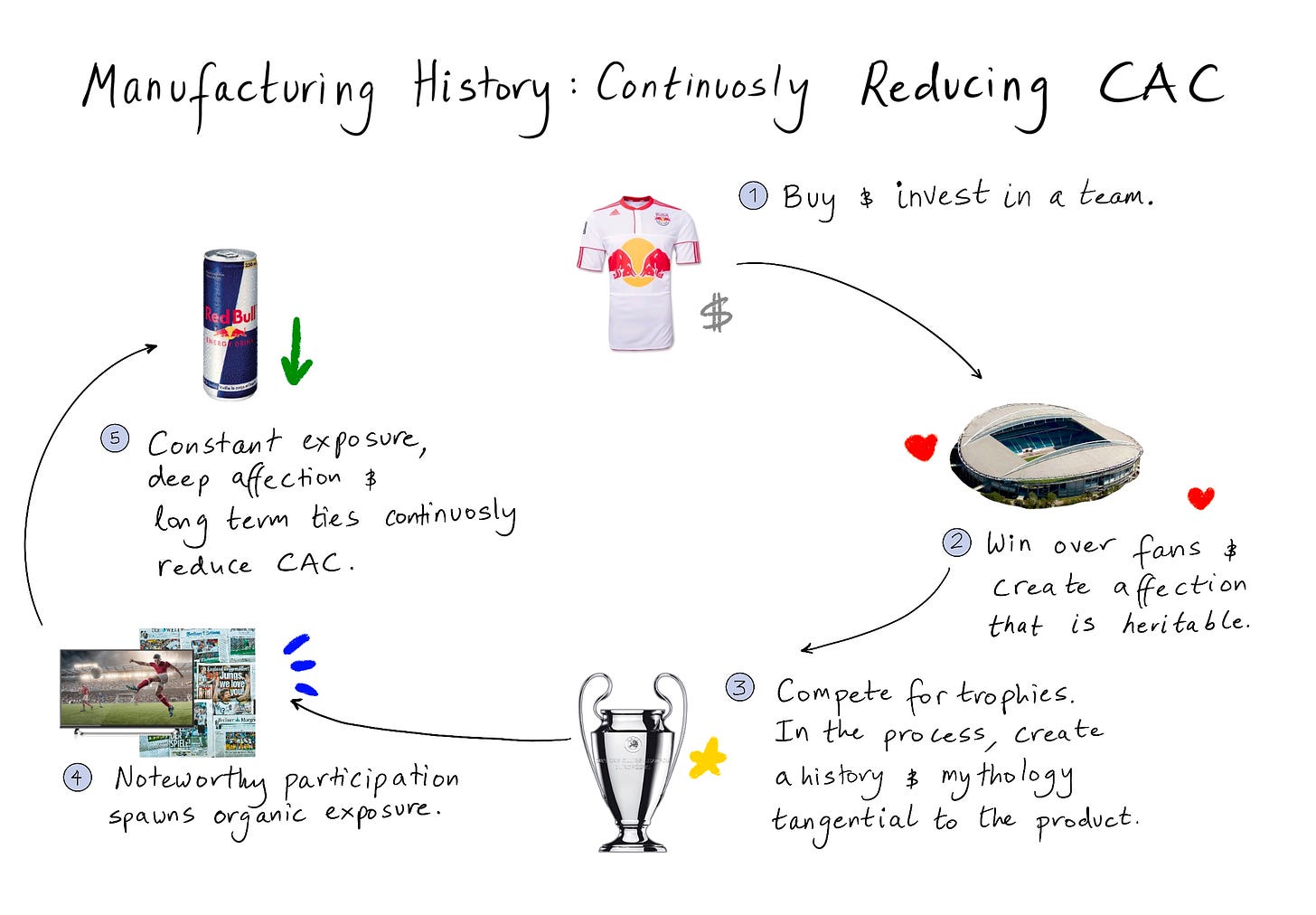A man falls from a great height and makes six billion dollars.
How did he do it?
It sounds like the start of a riddle, some fiddly enigma unlocked by the semantic reappraisal of a word, a letter, a sound. But this is no trap door or trick mirror. That's precisely what happened.
On October 12, 2012, Austrian skydiver Felix Baumgartner rose 24 miles into the air. He ascended in a silver pod, the shape of a milk pail, powered by a helium balloon. Above the ozone and more than 100,000 feet beyond the cruising altitude of passenger planes, Baumgartner rolled open the capsule's circular door and stood at its threshold. The earth, a dull brown and blue, swam beneath him.
He paused for a moment on the lip before uttering the words he must have rehearsed.
"I'm going home now," he said with a salute.
Then he dropped.
For over four minutes, Baumgartner fell. A tiny figure, tumbling, accelerating through an expanse of blue until he entered the realm of the supersonic, hitting Mach 1.25 and breaking the sound barrier. He was the first human to do so without the benefit of an engine.
By the time he landed, wafting to earth beneath a shimmering parachute, Baumgartner had made history. Just as important, so had his patron.
Red Bull had spent $50 million and seven years on the Stratos project. In its quest to break the record for the highest skydive, Red Bull enlisted expert engineers, medical staff, and others from the scientific community, running unmanned and manned practice jumps at lower altitudes.
It was, in its singlemindedness, a remarkable achievement and one that captured the world's imagination. One YouTube video of the jump has been viewed 43 million times; others racked up millions more. And all of it — the years of engineering, the mortal risk— was contrived to sell a fizzy drink.
It's worth pausing on the uniquely mind-boggling nature of that fact, the strangeness that a feat of science and human endurance was conducted in service of something so trivial; as if Wrigley's mapped the human genome to promote a pack of gum or Heinz orchestrated a Mars landing to promote a new relish.
Whatever its absurdity, it worked.
Economists estimated that Red Bull derived $6 billion in value from the Stratos project in the form of exposure. Critically, it's a figure that will only increase in time. That is the unique benefit of owning a piece of history — anytime the event is discussed, Red Bull, implicitly, profits.
This is the genius of Red Bull. Despite making no tangible good, the Austrian firm has created an empire, manifested a distinct personality, and constructed a mythos the envy of the consumer packaged goods (CPG) industry.
In today's briefing, we'll explore:
Red Bull's working-class origins
The marketing genius of Dietrich Mateschitz
A company that makes nothing
Manufacturing history
Learn how the best businesses win. Every Sunday, we send a free email that explains the business world’s most important innovations and the stories behind them. It’s high quality business analysis, delivered at no cost to you.
Yoovidhya: Creator of Krating Daeng
Chaleo Yoovidhya's rise mirrored that of Thailand's.
The son of Chinese farmers, Yoovidhya began his career as an antibiotics salesman before founding a company of his own: TC Pharmaceuticals. It represented a solid business throughout the 1960s, but it was in the following decade that Yoovidhya received the revelation he described as "divine inspiration."
Though energy drinks did not exist in the West at this point, they were a thriving business in Yoo's homeland, dominated by Japanese and South Korean brands like Lipovitan-D. These imports sold to Thailand's affluent urbanites and positioned their products as medicinal.
That didn't make sense to Yoovidhya. Why target the wealthy when it was the working man that needed extra energy? Having grown up in rural poverty, he understood the back-breaking work it took to make ends meet. Surely those were the people that would buy energy drinks, right?
Using his chemical knowledge, Yoovidhya studied competitors' compositions, recognizing a slate of shared ingredients: taurine, caffeine, glucose, and sucrose. With the core ingredients of his drink settled, Yoovidhya turned to the matter of branding. He wanted something uniquely Thai, something that spoke to the experience of the working class from which he'd come. He settled on a striking icon: the red gaur.
Indigenous to Southeast Asia, the gaur is the bovine family's largest species, a beast of mass and muscle reaching up to 7 feet tall and weighing 3300 pounds. While not the nimblest of creatures, its power and geographic identity encapsulated the spirit Yoovidhya hoped to capture. It proved the inspiration for the new product's name and logo. Translated, Krating Daeng means "Red Gaur." Yoovidhya's cans bore an illustration of two red gaurs charging towards one another before a yellow sun.
Krating Daeng was a hit. Within two years, it had become the country's most popular energy drink, displacing its foreign rivals. By pricing beneath competitors and aligning the beverage with Thai culture, Yoovidhya built a strong consumer base of rural laborers, factory workers, and long-route truck drivers. Foreshadowing what lay ahead, Yoovidhya bolstered Krating Daeng's positioning by sponsoring Muay Thai tournaments, an embodiment of the drink's Thai roots and invigorating effects.
Dietrich Mateschitz had the strong jaw and glossy smile of a toothpaste salesman, which he was, of course. A marketing director at Blendax, Mateschitz had little in his background to suggest a tycoon-in-waiting. He'd taken ten years to graduate from Vienna University, subsequently puttering along at Unilever selling laundry detergent, before his move to the toothpaste company.
In 1982, Mateschitz traveled to Bangkok to visit Blendax's local licensee: Chaleo Yoovidhya of TC Pharmaceuticals. Seeing his visitor exhausted and jetlagged, Yoovidhya offered Mateschitz a glass of his specially-brewed tonic. Almost immediately, Mateschitz was hooked.
"One glass and the jet lag was gone," he later said of the incident.
So began a ritual. Every time Mateschitz arrived in Bangkok, he would get his taxi driver to stop en route to the hotel so that he could pick up a refreshing can of Krating Daeng. It was a great product, Mateschitz must have thought, but could it be business?
As the story goes, it was only in browsing a business magazine that Mateschitz learned Taisho Pharmaceuticals — a purveyor of tonics and other medicinal products — was Japan's largest taxpayer. That sparked his interest. If Taisho could become a global behemoth peddling a similar product, what market might there be for Krating Daeng?
He was determined to find out. Mateschitz approached Yoovidhya with a proposition: what if the two men worked together to create a Westernized version of Krating Daeng? Yoovidhya would handle production — the European version would require only a few tweaks, Mateschitz thought — while the Austrian would worry about marketing and distribution.
Yoovidhya agreed. It was time to bring energy to Europe.
Mateschitz: Marketing genius
What German, Austrian, or Frenchman knew what a gaur was?
The first place to start was with a new name: Red Bull.
If Mateschitz thought that punchy brand and Yoovidhya's evocative imagery would prove alluring to European investors, he was sorely mistaken. Though canned soda was popular in the West, there was no established market for energy drinks, and even if there was, most people didn't want what Mateschitz was selling.
As Ogilvy Vice President Rory Sutherland described it years later, Red Bull was, from the very beginning, a paradoxical product:
[T]here's no evidence whatsoever, and there's no logic to suggest that there's a massive gap in the market for a drink that tastes worse than Coke, costs more than Coke, and comes in a smaller can. And indeed, if you'd have done market research [on Red Bull], everybody would have told you to get lost. And indeed, when they tested the taste, people did tell them to get lost.
Undeterred, Mateschitz plowed ahead. Without hope of securing outside funding, the Austrian invested $500K into the business, convincing Yoovidhya to do the same. As part of the deal, the duo agreed to take 49% each, with the remaining 2% going to Yoovidhya's son. Though that meant the Thai family technically had control over Red Bull, both agreed Mateschitz would run the ship.
With money in the bank and a formula he was happy with — the most significant change had been the addition of carbonation — Red Bull officially launched on April 1, 1987. In many ways, it was a company that seemed like an April Fools' joke — priced above other sodas and distributed in a strange, thin can.
That was all part of Mateschitz's strategy, of course. Unlike Yoovidhya, he saw opportunity in positioning Red Bull as elite, an upmarket drink for the glamorous and adventurous. To solidify that messaging, Mateschitz focused his outreach on Austrian ski resorts, bars, and clubs.
Leveraging an approach that has since become de rigeur, Mateschitz also paid popular university students to host parties that featured his product, often in unusual, attention-grabbing locations. He also decked out their cars, particularly Mini Coopers, with Red Bull logos. It represented one of the first "campus ambassador" programs and helped the company establish itself as a grassroots movement, not just another product. In later years, Mateschitz bolstered that rebellious identity by aligning the brand with extreme sports.
The approach worked with Red Bull selling 1 million cans in its first year. In the process, the company helped create and validate a new market. Today, energy drinks represent a global business with sales reaching $53 billion in 2018, growing at a CAGR of 7.2% through 2026. By that time, the industry is expected to be worth $86 billion.
As befits an innovator, Red Bull holds a commanding position with 43% market share, outstripping Monster (39%), Rockstar (10%), and others.
That dominance has been managed in an unusual fashion.
Red Bull: A brand that makes nothing?
As Geof Rayner, a Professor at Brunel University, summarized:
Red Bull is an interesting case because they don't make anything at all. It's an Austrian marketing company... that's it!... It is just a brand. Without any manufacturing plants or anything!
The partnership struck between Mateschitz and Yoovidhya solidified a structure that has carried through until the present day. Rather than manufacturing its core product, Red Bull outsources, relying on partners like Rausch, a juice producer. That allows Mateschitz's firm to focus on what it does best: marketing.
Over time, that's created a peculiar company, hell-bent on dominating the cultural conversation but disinterested in its actual product. Like one of Darwin's long-beaked finches, Red Bull bears the marks of a business with one specific attribute selected for over and over again: garnering attention.
That goes some way to explaining the baffling empire constructed over the last 34 years.
Today, Red Bull's sprawl includes:
Six soccer teams. RB Leipzig, NY Red Bulls, Red Bull Salzburg, Red Bull Ghana, and Red Bull Brasil.
Two Formula One teams. Red Bull Racing and Scuderia AlphaTauri
Two Esports teams. OG Dota 2 and Red Bulls.
One ice hockey team. EHC Red Bull München.
One Nascar team, Team Red Bull.
One apparel line, AlphaTauri.
One travel agency, Destination Red Bull.
One career support website, Wingfinder.
One stock music platform, Red Bull Sound Supply.
A media mini-conglomerate, Red Bull Media House. This includes dozens of TV shows and films, a record label representing artists like AWOLNATION, and an abundance of magazines and content sites. One of Red Bull's TV channels, ServusTV, attracts 5.7 million monthly viewers.
An events arm. This includes hundreds of events across sports, ranging from youth tournaments to professional competitions. "Flugtag," a "sport" invented by Mateschitz in which participants construct elaborate self-powered gliders, is a particularly unique offering.
An athletic sponsorship business, with the company supporting over 800 athletes across 90 different sports, including niche interests like luge, "mind gaming," snowmobiling, and wakeskating.
To repeat: Red Bull has a travel agency, a TV station with 5.7 million monthly viewers, and a fashion line.
This salmagundi makes it possible to imagine a deranged customer journey.
7:00 am. Wake up in the morning and pull on your new AlphaTauri "Janx" polo-shirt, "Puriv" pants, and "Okovo" parka made with high-performance Taurex® fabric (lol).
8:00 am. Grab a can of Red Bull on your way to the marketing job you found on Wingfinder.
8:30 am. Listen to Red Bull Media House's AWOLNATION on the subway ride over.
10:00 am. Pull royalty-free music from Red Bull Sound Supply to use in your company's new ad campaign.
2:00pm. Spend the afternoon procrastinating by looking up potential vacations on Destination Red Bull's site. Book a trip to Lake Garda.
6:30 pm. On the subway ride back, browse the latest edition of The Red Bulletin magazine, including the interview with Max Verstappen, a sponsored athlete and driver for Red Bull's Formula One team.
7:30 pm. Get home just in time to change into your AlphaTauri "Srono" loungewear and watch the RB Leipzig game.
True to form, Red Bull doesn't produce any of the tangible goods mentioned. Schoeller Textile AG produces AlphaTauri's collection, Destination Red Bull is a marketing layer on top of touring company The Travel Birds, and Red Bull Sound Supply is an imprint of stock music site Rebeat.
Observed from a distance, Red Bull might look like an ill-disciplined brand that doesn't control its own supply chain, produces nothing, and spends too much on marketing.
But squint, and it becomes clear that Red Bull makes something much more valuable than a fizzy drink or slick hoodie: history.
Don't miss our next briefing. Our work is designed to help you understand the most important trends shaping the future, and to capitalize on change. Join 64,000 others today.
Manufacturing history
On a relative basis, Red Bull's advertising spend eclipses larger beverage brands. Since Red Bull is still a privately-held business, precise details are scarce, but the company is believed to deploy 30-35% of revenues on marketing. With the company reporting $7.42 billion in revenue in 2020, an increase of 5.2% year-over-year, that implies annual marketing spend of roughly $2.5 billion.
For comparison, Coca-Cola allocated a reported $2.77 billion in global advertising in 2020, only slightly more than the Austrian firm, despite earning almost 4.5x the revenue. That places Coca-Cola's advertising spend as a percentage of revenue at 8.4%. In recent years, Nestle spent 7.8% of revenue, while Pepsico invested 4.4%.
Red Bull's anomalousness is a reflection of its strengths and weaknesses. As a defensive posture, Red Bull's spending looks like an attempt to keep an undifferentiated product relevant. Unlike Coca-Cola, Red Bull boasts no secret recipe, and as both Yoovidhya and Mateschitz illustrated, the cocktail of taurine, caffeine, and sugar is easily replicable.
But the imagination of Red Bull's marketing spending indicates the company is playing a different game. Rather than paying for sponsorships or purchasing ad space, Red Bull uses its hefty marketing budget to buy distribution and manufacture history.
Red Bull buys distribution by investing in media outlets, events, and sports teams. While Coca-Cola is happy to spend significant money on sponsoring a major sporting event — think the Olympics or World Cup — Red Bull takes this process a step further by hosting the event or even creating the sport.
Over time, the result of this decision is profound. Red Bull effectively changes a cost (paying for distribution) into a revenue opportunity (accepting sponsorships). While the company bears the cost of creating a new magazine, TV show, or motocross event, it can subsequently sell sponsorship slots across these distribution channels — in print, on the side of a car, on TV — all while ensuring prime visibility for its products.
Simultaneously, Red Bull creates assets with their own value. The company purchased its first Formula One team from Jaguar for $1 and the agreement that Red Bull would invest $400 million over the subsequent three years. As of 2018, Red Bull Racing was worth $640 million, lagging only Ferrari and Mercedes in brand value.
Similarly, the New York Red Bulls, an MLS franchise, was purchased for $25 million and is now worth $290 million.
The acquisition of sporting vehicles is particularly notable because it allows Red Bull's marketing strategy to meet its secondary goal: manufacturing history.
The best solitary instantiation of this is the Stratos project — Red Bull spent $50 million to break a world record and capture global attention. But the purchase of Formula One, soccer, and other sporting teams are more sustainable examples.
These efforts are interesting because they represent an attempt by Red Bull to permanently and continuously reduce its cost of acquisition. How does this happen?
Take the example of RB Leipzig, the company's most prominent soccer team. In 2009, Red Bull purchased the right to play in Germany's lower divisions from SSV Markranstädt for the princely sum of €350,000. RB Leipzig co-opted Markranstädt playing staff and expunged the old team's history as part of the deal.
For years, RB Leipzig climbed through the lower ranks of German football. Along the way, the team garnered fans from the local city, building a state-of-the-art stadium that began to fill with fans. By 2016, Leipzig had reached the Bundesliga, Germany's top division, an impressive achievement. The following year, they qualified for the sport's most prestigious club tournament, the Champions League, which they would reach again in 2019.
Though not exactly a Cinderella story — being bankrolled by a global beverage brand as an exercise of soft power doesn't scream "underdog" — RB Leipzig's rise is nevertheless a striking achievement and a genuinely exciting sporting project.
The club's value has accumulated significantly over the 12 years of its existence, but more importantly, Red Bull has created a mechanism through which it can fabricate a mythology. Like few other domains, sports possess reliable historicity: year after year, teams battle it out to win a championship. Those that succeed write their names in the annals of the sport. Even those that don't win fill out supporting roles and may achieve some other notable record in the process of competing. Critically, athletic allegiances are also highly heritable — the affiliation of a parent is passed to a child who passes it to a grandchild. Generations pass with constancy of devotion.
Through this lens, Red Bull's marketing strategy comes into clearer focus. In creating RB Leipzig, the company achieved the following:
Brand exposure to hundreds of millions of TV viewers
Media mentions, week after week
Natural placement in the conversations of sports fans
Heritable devotion within a growing fan base
Opportunity to be a part of sporting history
The result is that Red Bull is a part of the cultural consciousness in a way that can't be fully quantified. If we assume the point of marketing is to engender conscious and unconscious recognition and affection in a consumer's mind, Red Bull is an elite practitioner. Every week, millions of consumers worldwide discuss the exploits of one team or another — Scuderia Alpha Tauri or Red Bull Ghana — without thinking of the iconic silver can.
By focusing its investments on advertising vehicles that manufacture history, Red Bull has created an identity and mythology uniquely its own. As time passes, consumers may come to consider Red Bull a beverage brand, second, and a cultural institution, first.
One of America's great jurists, Oliver Wendell Holmes, once said, "A page of history is worth a pound of logic."
Like few other companies, Red Bull embodies the truth of that statement. While many companies seek to appeal to logos in selling their products, touting the unique advantages of some concoction or another, the brainchild of Yoovidhya and Mateschitz is animated by a different force: mythos. Rather than controlling production, Red Bull's owners have mastered the art of distribution in a manner distinct from its competitors.
By focusing on athletic events and teams, Red Bull has not only embodied a lifestyle, it has positioned itself such that it can benefit from the manufacturing of history, legacy. In doing so, it takes a place in the culture's conversation, continuously builds brand recognition, and reduces CAC.
As the internet continues to catalyze new brands and simplifies global access, brand and distribution seem increasingly likely to become the battleground for differentiation.
No one knew what would happen to Felix Baumgartner when he stepped from the Stratos capsule. In falling from the "edge of space," he placed his body into significant peril. Dr. Joe Clark, the project's lead, mentioned in advance that he was unsure of what breaking the sound barrier would do to Baumgartner, highlighting the possibility for his body to create a "powerful blast wave" that might cause him harm. In descending safely, Baumgartner meaningfully contributed to scientific understanding, particularly for projects in the aviation industry.
As the fight for attention escalates, it's intriguing to wonder what miraculous moments will occur and under what banal consumer banner they will be undertaken.
The Generalist’s work is provided for informational purposes only and should not be construed as legal, business, investment, or tax advice. You should always do your own research and consult advisors on these subjects. Our work may feature entities in which Generalist Capital, LLC or the author has invested.



